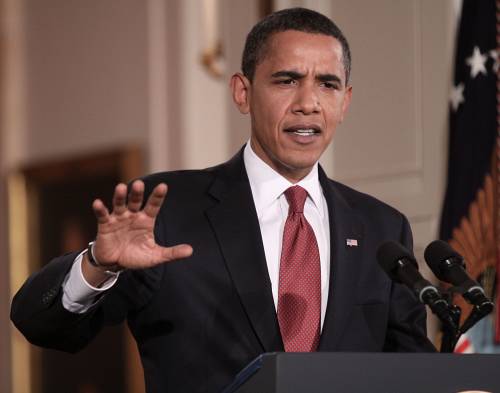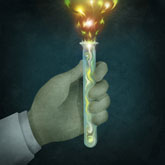U.S. Stand Jeopardizes Global Anti-HIV Push
United Nations drug policy framework is scheduled to be approved next week, with the United States breaking from much of Europe and Canada.
Jul 31, 2020121.9K Shares2M Views
President Barack Obama (WDCpix)
The Obama administration’s opposition to controversial drug treatment programs has helped kill a prominent global effort to prevent the spread of HIV/AIDS and other diseases among drug users.
Gathered in Vienna, members of the United Nations are drafting a nonbinding framework to guide the next decade’s international drug policy. The United States has rejected initial language promoting “harm reduction” measures, which include needle exchanges, safe injection facilities, drug substitution therapies and other programs designed to mitigate the damaging effects associated with illegal drug use. In doing so, the biggest U.N. contributor has, in effect, condemned certain drug abuse programs supported by some of its closest allies.
Illustration by: Matt Mahurin
Many countries — most in Europe, but also including Canada and Australia — have adopted some of these programs on their own, arguing that monitoring drug use not only offers a safer alternative to criminalizing it, but also provides a clearer path to treatment and recovery.
While the Obama White House has come out squarely in support of clean-syringe programs, it opposes the broader reference to harm reduction on the grounds of the term’s ambiguity. Largely due to U.S. opposition, no mention of either harm reduction or needle exchange will appear in the U.N. declaration, which is set to be finalized next week during a special meeting of the U.N. General Assembly. The document, to which no funds are attached, will next be updated in 2019.
The White House position is some indication that, despite early signals that the Obama administration intends to refocus the nation’s drug policies on public health, the decades-old law enforcement mentality — encapsulated by the Reagan-era “war on drugs” slogan — still rules the day in Washington.
Many health care advocates and human rights groups are blasting the administration’s stand against harm reduction, arguing that it represents a missed opportunity to approach drug abuse from the pragmatic angle that its eradication is a practical impossibility. Some blame an old-school thinking they say is embedded among senior State Department and other agency officials — holdovers from other administrations who view drug policy strictly through the lenses of law enforcement.
“Inertia took over,” said John Walsh, senior associate for drug policy at the Washington Office on Latin America, a human rights group. “The people in place have been adamantly opposed to harm reduction, and they’re the ones advising the White House what to do.”
In a statementexplaining the White House opposition to harm reduction, Geoffrey R. Pyatt, deputy chief of the U.S. mission to the U.N. in Vienna, emphasized the administration’s support for needle exchange programs and “other evidence-based approaches to reduce the negative health and social consequences of drug abuse, including access to medication-assisted treatment for narcotic addiction.”
“However,” Pyatt continued, “the United States continues to believe that the term ‘harm reduction’ is ambiguous. It is interpreted by some to include practices that the United States does not wish to endorse.”
Such practices, according to State Department spokeswoman Laura Tischler, include drug legalization, drug consumption rooms, heroin prescription initiatives and programs to provide drug paraphernalia that has no tangible health benefit to the user.
Other opponents of harm reduction measures argue that they represent a slippery slope toward acceptance and greater drug use. The website for the Drug Free America Foundation, for example, urges policymakersto “reject ineffective harm reduction tactics that ask society to accept drug use or allege that drugs can be used safely or responsibly, creating the misunderstanding that drug use itself is not harmful and increasing addiction.”
Drug reform advocates are cheering the White House acceptance of needle exchanges, which marks a sharp break from two decades of federal policy. But they quickly add that, in opposing harm reduction, the administration didn’t go nearly far enough to fulfill its leadership role on the global stage.
“This is not the Bush administration,” said Rebecca Schleifer, advocate for the health and human rights division at Human Rights Watch. “But they have a long way to go before they really endorse evidence-based measures.”
Daniel Wolfe, director of the Open Society Institute’s harm reduction development program, was even more blunt. “They took a half step,” he said, “when a bold step was needed.”
The episode has also angered much of Europe, where many countries have already adopted some of the same harm reduction programs that the United States has come out against. The European Union, in near unanimity, had fought fervently to include harm reduction in the U.N. declaration.
To no avail.
An informal vote taken this week in Vienna by members of a U.N. narcotics panel found the United States siding with Russia, Japan, Iran and nine other countries in opposition to mentioning harm reduction in a footnote of the U.N. declaration. Following that straw poll vote, according to sources in the room, the panel chairwoman, representing Namibia, snipped the language from the document, and the debate was over.
One European delegate present during the vote called the episode “the best example of a morally bankrupt and systemically corrupt outcome that I have yet encountered in any political negotiation I have ever been in.”
At least five countries — Germany, the Netherlands, the United Kingdom, Portugal and Spain — have announced plans to submit a reservation to the declaration to protest the exclusion of the harm reduction clause. (Reservations, in this process, are symbolic gestures of discontent, published as an addendum to the official declaration but not appearing in the document itself.)
A number of studies indicate the protesters have some reason to be agitated. Three years after a safe injection facility opened in Vancouver in 2003, for example, researchers found that the experiment had reduced public drug use, publicly discarded syringes and needle sharing among local drug users. A similar studyconducted around a heroin prescription facility in Montreal reached similar conclusions. Both studies found that there was no increase in drug trafficking or other drug-related crimes in the vicinity of the facilities.
Given the evidence, some advocates have questioned Pyatt’s reference to the United States “evidence-based approaches.”
“It’s almost as if they’re denying that any research outside of the U.S. is legitimate,” said Allan Clear, executive director of the Harm Reduction Coalition, an advocacy group.
There are other reasons that drug policy reformers are puzzled by the Obama administration’s sharp opposition to harm reduction. First, the United States is already on record endorsing the strategy. A 2006 U.N. declaration on HIV/AIDS urges countries to adopt a “wide range of prevention programmes” including “harm reduction efforts related to drug use.” The measure passed by a consensus of the General Assembly.
And second, the language in the declaration is nonbinding, meaning that it would neither force countries to adopt harm reduction programs, nor prevent them from doing so. Still, advocates are quick to point out that the absence of the harm reduction language means that no country will be encouraged to consider programs that have been proven to alleviate the ill side-effects of drug abuse. The importance of the language, Walsh said, is to “make it clearer that these programs and strategies are accepted.”
Figures tallied by the World Health Organizationreveal the issue is much more than symbolic. WHO estimates that, worldwide, dirty drug needles cause 10 percent of all new HIV cases. In Eastern Europe and Central Asia, WHO says, the number rises to 80 percent. “WHO strongly supports harm reduction as an evidence based approach to HIV prevention, treatment and care for drug users,” the group’s Website reads.
The controversy has not eluded the watchful eyes of Congress. In January, several powerful Democrats wrote to Susan Rice, U.S. ambassador to the U.N., asking the administration to explain its resistance to harm reduction language in the UN declaration.
“We risk crafting a U.N. declaration that is at odds with our own national policies and interests, even as we needlessly alienate our nation’s allies in Europe,” wrote Reps. Henry Waxman (D-Calif.), Barbara Lee (D-Calif.) and Jose Serrano (D-N.Y.).
It’s unclear if Rice’s office responded to the lawmakers’ concerns. Calls this week to the offices of Waxman, Lee and Serrano were not returned.
The United States is not the sole reason that harm reduction was plucked from the UN’s drug policy manifesto. In the middle of February, the Vaticanissued a statement arguing that, “So-called harm reduction leads to liberalisation of the use of drugs, to an increase in the number of addicted people and to blurring of consciences, leading also to the loss of one’s free will.”
The move caused Italyto announce its opposition as well, in effect breaking the E.U. block of support for harm reduction.
Still, the United States — which is far and away the most generous supplier of U.N. funding — holds considerable sway over U.N. deliberations. Observers contend that the White House could have pressured other members to accept the harm reduction strategy — if it chose to do so.
“The U.S. does tend to use its super-donor status to run the debate,” said Wolfe of the Open Society Institute. “This is not a unique story.”
Some health care and drug reform advocates have maintained a glimmer of hope that next week’s U.N. gathering will somehow find the harm reduction clause returned to the drug policy document. Many others, however, are resigned to accept the draft as it stands. And they’re not pleased with the content — nor the process that brought it about.
“It’s fair to say,” said Walsh of the Washington Office on Latin America, “that the document that comes out of the convention will not be a reflection of the actual debate.”

Rhyley Carney
Reviewer
Latest Articles
Popular Articles

